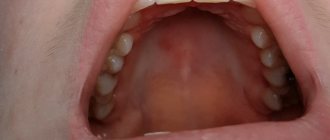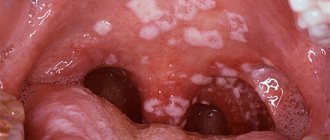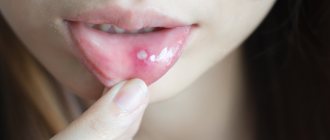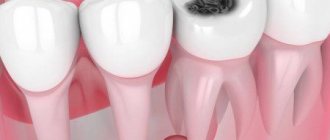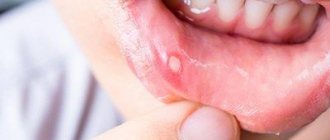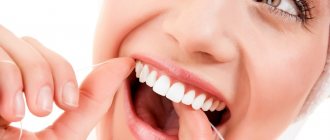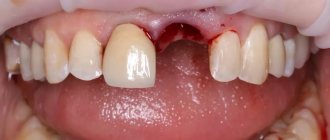The oral mucosa is capable of quickly regenerating, since it is lined with several layers of epithelium, which is constantly renewed. In addition, it is resistant to irritants of various origins and infections.
However, small ulcers often occur on the lining of the mouth, particularly the roof of the mouth, causing discomfort and pain.
Ulcers on the roof of the mouth appear due to:
- Eating crackers, nuts, fish. Products with sharp edges can scratch the epithelium, leading to the formation of ulcers.
- Chemical and thermal burns of the palate (hot food and drinks, careless handling of acids).
- In children, the mucous membrane can be damaged due to improper and rough oral hygiene.
Ulcers as a symptom of the following diseases:
- candidiasis;
- herpes;
- tuberculosis;
- stomatitis;
- syphilis;
- scarlet fever;
- endocrine disorders.
Symptoms
Ulcers, or in scientific terms aphthae, cause a lot of inconvenience, so they cannot be asymptomatic and a person will immediately understand that the mucous membrane of the palate is not in order:
- Due to the appearance of ulcers, the mucosal tissues swell, and this can make speech difficult.
- It is impossible to eat hot, spicy, sour and salty foods, as they will irritate the damaged surface of the palate.
- A person, even with his mouth closed at rest, may experience pain, and in advanced cases, the ulcers bleed.
Not all canker sores are harmless.
Of course, if they were formed due to mechanical damage to the mucous membrane, they will go away on their own in the shortest possible time. If the ulcers do not go away, you need to track the accompanying symptoms in time to begin treating systemic diseases:
- When the herpes virus enters the oral mucosa , a person’s condition generally worsens, body temperature may rise, lymph nodes enlarge, salivation increases, and then small wounds form on the palate.
- Often, with a decrease in immunity or long-term use of antibiotics, it is possible to develop a disease such as candidiasis or thrush of the oral mucosa. In this case, a burning sensation is felt, taste sensations are lost, and a characteristic white coating of a cheesy appearance forms on the entire mucous membrane; eventually, aphthae can form on the palate, which sometimes bleed.
- When infected with syphilis at the beginning in the oral cavity , a rash may occur, which then develops into ulcers on the soft tissue of the palate and cheeks.
- Aphthous stomatitis. A chronic disease characterized by inflammation of the oral mucosa and the appearance of ulcers on the palate. Besides. such stomatitis can be a symptom of generalized aphthosis, a disease that affects all mucous tissues in humans (gastrointestinal tract, genitals, eyes). Ulcers form gray-yellow in size from 2 to 10 mm, depending on the course and stage of the disease. They are quite deep, painful, do not heal for a long time and often recur.
- With pulmonary tuberculosis , initially small compactions in the form of reddened tubercles may form on the palate, which then transform into shallow round wounds.
Causes
The formation of mouth ulcers on the palate occurs for various reasons. Most often their appearance is provoked by:
- consumption of foods that injure the oral mucosa: crackers, chips (also leads to the formation of ulcers);
- taking hot drinks, food;
- oral care rules
Other causes of ulcers on the palate:
- Incorrectly installed or poorly selected dentures .
- extraction and filling .
- Brushing your teeth with a paste that contains sodium sulfate: the mucous membrane becomes susceptible to bacteria and food acids.
- Genetic predisposition. If relatives experience frequent relapses of stomatitis, the likelihood of developing the disease increases several times.
- Malocclusion .
- Allergies to food (chocolate, citrus fruits), oral care products.
- Taking antibiotics, hormonal drugs.
- Eating unwashed fruits and vegetables.
- Fungal infections.
- Hormonal imbalance is one of the causes of ulcers on the palate in women during pregnancy, menstruation, and menopause.
- Alcohol abuse , tobacco addiction.
- Frequent stress.
- Low immunity.
- Diseases of the digestive system.
- Deficiency of fluid, vitamins and minerals in the body.
Sometimes sores on the palate are a sign of systemic diseases. The appearance of mouth ulcers may indicate:
- Tuberculosis.
- Syphilis.
- Disturbances in the functioning of the pancreas and thyroid gland (the appearance of wounds on the mucous membrane of the palate is observed in diabetes mellitus, toxic goiter).
- Necrotizing gingivostomatitis.
- Oncological disease. A malignant tumor may also be accompanied by the appearance of long-term non-healing ulcers on the palate, but they are rare.
It is difficult to independently determine what caused the wounds on the palate. But if you pay attention to the clinical signs of pathology, you can help the doctor quickly make a diagnosis and select effective treatment.
If an ulcer on the roof of your mouth appears after starting a new medication, you should contact your doctor.
The specialist should select a less aggressive analogue or offer local remedies to protect the oral mucosa from irritants.
Dentist
Novikova Olga Alexandrovna
8 years of experience
Diagnostics
If aphthae occurs on the roof of your mouth, you should contact your dentist.
The doctor will examine the oral mucosa and may ask the following clarifying questions:
- How long ago did the ulcers appear?
- How painful are they?
- Do they bleed?
- Does the patient smoke or not?
- What are the common chronic diseases, and what diseases were recently suffered?
- Do any of your relatives have similar ulcers?
Your doctor may order a blood test and, in extreme cases, a biopsy. If the dentist believes that aphthae appeared as a result of some disease that is not within his competence, he will refer you to the appropriate specialist. Otherwise, he prescribes treatment himself.
When to contact a specialist
It is necessary, however, to note that, despite the apparent effectiveness of using traditional methods of treating wounds in the mouth, still at the first signs of the appearance of ulcers, wounds or other, even the most minor, foci of inflammation in the mouth, it is necessary to immediately contact a dentist in order to obtain a qualified consultation and effective, timely and professional treatment.
Advanced diseases that have become chronic can cause various kinds of complications and are much more difficult to eliminate than those detected in time.
Treatment
If wounds on the palate appear as a result of mechanical damage, then no special measures should be taken.
The only thing is to eliminate the cause of their formation, that is, avoid foods with sharp edges, brush your teeth more carefully, take a break from eating sour, salty and hot foods. The epithelial tissues will renew themselves, and the palate will return to normal.
You can rinse your mouth with a collection of medicinal herbs such as chamomile, sage, calendula.
Treatment of aphthae caused by some diseases of the body must be carried out in three directions:
- Eliminating the cause of ulcers.
- Local treatment of ulcers, their permanent treatment.
- Relieving pain.
To eliminate the causes, you must first increase your overall immunity.
The doctor may prescribe general health-improving medications and vitamin-mineral complexes. To eliminate swelling, antihistamines are prescribed at the discretion of the specialist. If the wounds cause severe discomfort, painkillers containing paracetamol or ibuprofen are used.
In case of acute pain, before contacting a specialist, it is possible to use lidocaine in a spray. If the cause of aphthae on the palate is a disease such as candidiasis, the doctor will prescribe antifungal drugs, for example, Diflucan or Flucostat.
If the cause lies in herpes, antiviral drugs are used, for example, Zovirax or Acyclovir.
Ulcers caused by bacterial infections require more serious treatment with antibiotics of various groups.
Aphthae that appear against the background of tuberculosis, syphilis and other infections are treated with appropriate anti-tuberculosis, anti-syphilitic and antiviral drugs.
For local treatment of ulcers, doctors usually prescribe rinsing with antiseptic solutions (for example, chlorhexidine solution or miramistin). Rinsing with pharmaceutical herbs has also proven to work well. Levomekol can be used as an ointment.
Features of manifestation
It is impossible not to notice wounds or pustules in the oral cavity: they are visible upon visual examination and cause significant discomfort to the patient. Common symptoms of mouth ulcers:
- swelling of the palate;
- difficulty speaking;
- pain when eating salty, sour or hot foods;
- bleeding from the mouth.
The clinical picture may be supplemented by other symptoms: it all depends on the form of stomatitis.
Ulcers on the palate appear as a result of a violation of the integrity of the oral mucosa. Accompanied by speech impairment, swelling, pain, and bleeding gums.
Depending on the degree of damage, the clinical picture is complemented by other signs.
Treatment depends on the underlying cause of the ulceration.
Catarrhal - manifests itself in the form of white spots, which gradually turn into wounds. Signs:
- excessive salivation;
- pain when chewing food;
- bad breath .
Aphthous - characterized by the appearance of ulcers with a gray coating, cell death at the site of their occurrence. If its course is complicated, it is possible:
- damage to the salivary glands;
- scarring of palate tissue;
- deformation ;
- inflammation of the lymph nodes.
Allergic – appears upon contact with an allergen. The development of stomatitis of this form is possible when taking medications or dental interventions. The patient has complaints about:
- dry mucous membranes;
- itching, metallic or sour taste in the mouth;
- difficulties with eating .
Candidiasis is caused by fungi that constantly live in the oral cavity. If the immune system is impaired or the rules of dental care are neglected, their number increases. This results in sores on the roof of your mouth, gums, or cheeks. Its main features:
- burning sensation in the mouth;
- a coating on the palate of a cheesy consistency.
Bacterial - caused by the herpes virus, staphylococci and streptococci. Usually occurs with chickenpox, measles, influenza, rubella. With a long course of the disease, the following symptoms appear:
- high temperature ;
- weakness ;
- purulent discharge from the mouth (observed if there is an infection);
- sepsis (in advanced cases).
When ulcers on the palate are a manifestation of systemic diseases, the clinical picture is slightly different.
The clinical manifestation of stomatitis and systemic diseases have similar symptoms. If you self-medicate, this can lead to a deterioration in your health and the development of complications. Recommendations for the treatment of mouth ulcers should be given by a doctor after determining the cause of their occurrence.
Folk remedies for the treatment of ulcers on the palate
For rinsing, you can use thyme herb, brewed in boiling water, waiting until it cools to room temperature.
There are many traditional medicines that can relieve pain from wounds on the palate or help relieve inflammation:
- Dilute 1 teaspoon of salt and 1 teaspoon of soda in a glass of boiled warm water. Rinse your mouth with this solution 3 times a day.
- Dilute 2 teaspoons of calendula tincture in a glass of boiled water, rinse 2 times a day.
- Use freshly squeezed carrot juice diluted with water for rinsing 3-4 times a day.
- Grate raw potatoes on a fine grater and use the resulting pulp as a lotion for canker sores.
- Many people find that smearing ulcers with honey helps.
- One of the folk recipes suggests using the following option: you need to mix half a glass of milk with 1 egg yolk and a spoonful of honey. Mix the mixture well until smooth, then wrap your finger in a clean sterile cloth or bandage, dip it in the mixture and wipe the wounds. It is enough to wipe 3-4 times a day for 3 days.
It should be remembered that you should not get too carried away with folk remedies. With their help, you can relieve symptoms, relieve minor inflammation, or help the mucous membrane regenerate faster. The search for and treatment of the main cause of ulcers on the palate should be carried out by a specialist.
Prevention
What to do and what not to do:
- It is necessary to strictly observe oral hygiene.
- Visit the dentist 2 times a year.
- It is advisable to minimize sour, spicy, salty foods in your diet, and try not to eat too hot food, which can burn the mucous membrane of the palate.
- It is necessary to determine whether there are any allergies to any food products, because they can cause ulcers to appear on the palate.
- It is recommended to take vitamin complexes, and also monitor the level of iron, zinc and folic acid in the body, because their lack provokes aphthae.
- Doctors also recommend strengthening the immune system and avoiding emotional stress.
If you follow preventive measures and start treatment at an early stage, you can avoid such troubles as ulcers on the palate.
